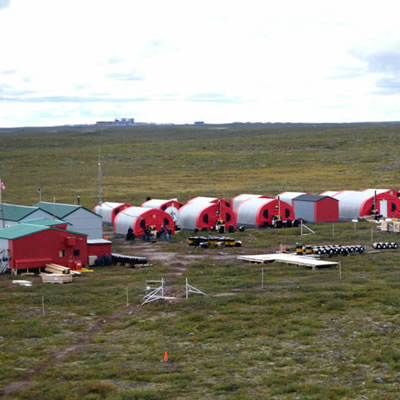Kennady files NI 43-101 Faraday resource report on SEDAR

Aerial view of the Kennady North Project, located in the Northwest Territories. — Photo courtesy Kennady Diamonds TORONTO, Nov. 20, 2017 /CNW/ - Ken
Aerial view of the Kennady North Project, located in the Northwest Territories. — Photo courtesy Kennady Diamonds
TORONTO, Nov. 20, 2017 /CNW/ - Kennady Diamonds Inc. ("Kennady", the "Company") (TSX-V: KDI) is pleased to announce the filing on Sedar of a National Instrument ("NI") 43-101 technical report titled "Project Exploration Update and Faraday Inferred Mineral Resource Estimate, Kennady North Project, Northwest Territories, Canada" dated effective November 16, 2017 (the "Technical Report"). The Technical Report describes the maiden Inferred Mineral Resource of 5.02 million carats for the Faraday kimberlites announced in the Company news release dated October 3, 2017. The report also provides an overview of exploration work completed on the Kennady North Project to date, as well as a summary of the Indicated Mineral Resource of 13.62 million carats of diamonds for the Kelvin kimberlite that was the subject of previous Technical Report published on January 24, 2017.
President and CEO of Kennady Diamonds Dr. Rory Moore stated: "I congratulate our technical team and the authors of the report, Mr. Gary Vivian and Dr. Tom Nowicki for a job well done. The addition of the high-value Faraday resource to the existing Kelvin resource represents another significant milestone for Kennady towards its goal of growing the economic diamond resource on the Kennady North Project."
Faraday Inferred Mineral Resource
The Inferred Mineral Resource of 5.02 million carats of diamonds declared for the Faraday kimberlites is contained in 3.27 million tonnes of kimberlite, with an overall grade of 1.54 carats per tonne and an average value of US$98 per carat. The resource has been calculated with a 1mm diamond bottom cutoff size, which is considered a reasonable cutoff for a commercial mining scenario. The resource was determined through the collective efforts of Aurora Geosciences Ltd., Mineral Services Canada Inc., and SRK Consulting Inc., who were engaged by the Company to participate in the exercise.
The Faraday Mineral Resource estimate is based on four main components:
- A geological model that defines the boundaries of the deposit (external pipe shell) as well as the geologically distinct domains of which it is comprised;
- Estimates of average bulk density for each domain which, in combination with volumes derived from the geological model, provide estimates of the tonnes of kimberlite present;
- Estimates of average grade (carats per tonne) for each domain based on LDD grades corrected for recovery efficiency in a commercial-style process plant; and
- Estimates of the average value of diamonds within each domain.
The NI 43-101 Standards and Canadian Institute of Mining and Metallurgy guidelines for Mineral Resources and Mineral Reserves stipulate that a Mineral Resource needs to have a "reasonable prospect of economic extraction of the specified ore". Mineral Services concluded that the Faraday kimberlites have reasonable prospects for eventual economic extraction by virtue of their close proximity and similar overall diamond grade and value to Kelvin, for which such prospects have recently been demonstrated (see News Release of December 12, 2016). Inferred Mineral Resources are considered too speculative geologically to have the economic considerations applied to them that would enable them to be categorized as Mineral Reserves. Mineral Resources are not Mineral Reserves and do not have demonstrated economic viability.
Faraday Target for Further Exploration (TFFE)
The volume, tonnes, grade and average diamond value for the Faraday 1 kimberlite and for two minor domains of Faraday 2 are not sufficiently well constrained by available data to define Mineral Resources.
The estimate of TFFE is conceptual in nature as there has been insufficient exploration to define a Mineral Resource and it is uncertain if future exploration will result in the estimate being delineated as a Mineral Resource.
Neither the TFFE nor the Inferred Resource for Faraday 2 take into account the results from the summer 2017 drilling program, which extends the kimberlite to the north by 150 meters (see news release, September 11, 2017). An image summarizing the latest drilling for Faraday 2 can be viewed on the Company website at www.kennadydiamonds.com.
About Kennady Diamonds
Kennady Diamonds Inc. controls 100 percent of the Kennady North diamond project located in Canada's Northwest Territories. Kennady North is adjacent to the Gahcho Kué Diamond Mine, a joint venture between De Beers Canada (51%) and Mountain Province (49%). Kennady is focused on expanding its high-grade diamond resources along the Kelvin–Faraday kimberlite corridor, as well as identifying new kimberlites outside of the corridor. To date an indicated resource of 13.62 million carats of diamonds contained in 8.50 million tonnes of kimberlite, with a grade of 1.60 carats per tonne and an average value of US$63 per carat has been defined for the Kelvin kimberlite and an inferred resource of 5.02 million carats contained in 3.27 million tonnes of kimberlite, with a grade of 1.54 carats per tonne and an average value of US$98 per carat has been defined for the Faraday kimberlites using a 1mm diamond bottom cutoff size. The Kelvin – Faraday corridor is also a target for further exploration.




